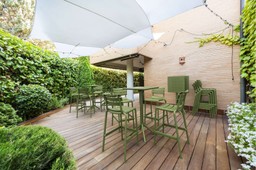The Ultimate Showdown: Deciding Between Timber vs. Polypropylene Furniture
September 17, 2024Should you stick with the safe, traditional option or its bold, younger rival?
Whether you’re launching a new furniture dropshipping venture or seeking to broaden your existing product range, selecting the right products is critical to maximising profit margins and expanding your customer base.
Understanding your target demographic is essential for choosing furniture designs that appeal to their preferences and values, from aesthetics to durability and functionality. Based on our data, timber and polypropylene are among the most popular materials for hospitality furniture, favoured by both resellers and customers.
In this blog, we’ll discuss the pros and cons of timber and polypropylene hospitality furniture, providing valuable insights to help you make an informed choice for your business.
Let’s Explore the Pros & Cons of Polypropylene vs. Timber for Your Furniture Business
Polypropylene Hospitality Furniture
Unlike other low-quality plastic varieties, polypropylene is a high-performance thermoplastic polymer that becomes pliable when heated and solidifies upon cooling, making it exceptionally versatile for various applications.
Though rapidly increasing in popularity among retailers and customers, polypropylene may often be misunderstood as yet another plastic option despite its extensive capabilities.
Pros of Propylene Furniture
✔️ Design versatility
Polypropylene is an incredibly adaptable material that can be transformed into various furniture designs, shapes, and colours, catering to diverse aesthetic preferences.
✔️ Indoor & outdoor usage
Polypropylene has excellent thermal properties, is highly resistant to fading and cracking, and is waterproof, making it the ideal material choice for both indoor and outdoor settings.
✔️ Durability & longevity
Perfect for high-traffic and outdoor applications, polypropylene is highly durable and won’t rust, rot, or degrade quickly.
✔️ Low maintenance
Unlike other materials that require regular upkeep or specialised care, polypropylene can be easily cleaned with soap and water, prolonging its appearance with minimal maintenance.
✔️ Lightweight strength
Despite its strength, polypropylene is exceptionally lightweight compared to materials like timber and metal, maximising its portability in busy settings.
✔️ Affordability
Polypropylene furniture is generally more cost-effective than timber or upholstered options.
Cons of Propylene Furniture
❓ Quality misconceptions
Some customers may perceive polypropylene furniture as being of lower quality than natural materials like timber. This can affect its appeal to those who prioritise traditional aesthetics and materials.
❓ Environmental concerns
Although polypropylene is fully recyclable and can be repurposed, a lack of education or awareness about its sustainability benefits may lead to improper disposal practices.
Timber Hospitality Furniture
Timber has long been a favoured material in residential, hospitality, and commercial furniture due to its timeless elegance and inherent natural beauty. Its classic appeal makes it an excellent choice for adding warmth and sophistication to any environment.
When sourced sustainably, timber offers eco-friendly, recyclable qualities to support environmental responsibility and sustainable practices.
Pros of Timber Furniture
✔️ Timeless aesthetic appeal
Timber adds a touch of classic sophistication and natural luxury to any indoor or outdoor space. It offers customisation possibilities through staining or painting and beautifully complements various decor styles.
✔️ Environmental benefits
When sourced using responsible forestry practices, timber furniture is an environmentally friendly choice. It can be recycled or refurbished at the end of its lifecycle, making it an ideal and sustainable furniture solution.
✔️ Longevity
With proper care, timber furniture can last for generations, making it a durable and long-lasting investment.
Cons of Timber Furniture
❓ High maintenance
Timber requires regular upkeep to minimise and prevent issues such as scratches, weathering, water damage and unsightly heat marks. It demands ongoing cleaning, buffing, and polishing to maintain its appearance, particularly if used in outdoor settings.
❓ More expensive
High-quality, sustainably sourced timber furniture is more expensive than polypropylene, which might be an important decision-making factor for budget-conscious buyers.
❓ Heavier weight
Compared to polypropylene or plastic options, timber is a typically heavier material, which may make it less portable in busy settings that require easy reconfigurations or flexible layouts.
So, which hospitality furniture material should you choose for your business?
Both timber and polypropylene lend unique advantages and disadvantages that will influence your choice, depending on your customers’ needs and the environments in which the furniture will be used.
Polypropylene furniture is ideal for indoor and outdoor settings. It is remarkably durable, portable, and low-maintenance for high-traffic hospitality and commercial applications. With a huge range of designs, polypropylene is a wonderful option for those who enjoy its versatility and modern aesthetics.
Conversely, timber furniture is a long-term investment offering timeless aesthetics and environmental benefits. Due to its typically higher perceived value, timber may be preferred for high-end or more traditional, luxurious settings such as upper-tier restaurants and private residential homes.
Ultimately, by better understanding each material’s pros and cons, you can make a more confident selection to complement your range, aligning with your target demographic’s preferences, budget, and intended use.
As your trusted partner in wholesale hospitality furniture, we’re here to support your goals and provide the tailored insights you need to succeed.
Contact our friendly team for more detailed information on the different types of hospitality furniture available.

